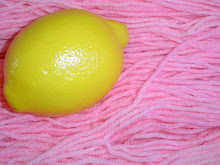A Hidden Gnome!
I'm still working on my first sock of the new pair (why does stranded knitting take so much longer than single color knitting?), but I'm past the heel turn and the gusset now. You can see the little gnome above, between the gusset decreases. He's technically knit into the gusset of this sock, and he sits right on the underside of the heel. You can barely see him in the photo below
When I started the stranded section for the foot, I decided to use a smaller needle than what I used for the stranded section of the leg. I tried on the sock, and the leg portion is looser than I like the feet of my socks to be. For anyone who's interested, I used US 0'S (2.0mm) for the top ribbing, heel flap, heel turn, and foot colorwork. I used US 1's (2.25mm) for the leg colorwork. This tightened up my gauge on the foot section so it will fit more snugly. This also means I will have to knit more rounds in the foot to get the length right.
Labels: ESK, socks, Stranded Colorwork












1 Comments:
How many stitches did you cast on for the sock?
Post a Comment
<< Home